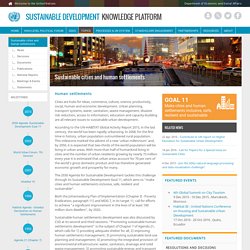

Mapping Segregation. Create A City: An Urban Planning Exercise. EkissCityT. English Language Listening Library Online: Learn from over 800 activities. American Cities OK, hello, I'm going to talk a little about American Cities.

I'm going to talk about five American cities that are very famous to Americans and their nicknames and a little history about each of them. New York OK, the first city, probably the most well-known city in America, is New York, and in America we call New York "The Big Apple" and it's probably the biggest city in the United States and it's very diverse.
It has a very multi-cultural population. People from all over the world come and live in New York and we say that New York is "the city that never sleeps" because there is always something going on. Boston Not too far from New York is Boston. Top 10 green U.S. cities. Image EU series TV TBACPRO. Image EU series TV TBACPRO. La géographie des Etats-Unis : filmographie. - Clio-Ciné. Samuel Serre Ghost World qui traite de l’ennui de deux adolescentes dans une banlieue blanche de classe moyenne (c’est tiré de la BD éponyme qui est elle aussi de très grande qualité) Les films de Jarmusch - notamment les deux premiers (Stranger than paradise et Down by Law).

Le premier est utile pour New York notamment dans un long plan séquence du début qui permet de voir un quartier populaire et délabré du centre de NY dans les années 80. Le second traite de la Louisiane et est peut être moins directement utilisable. Les films des frères Coen sont eux aussi une mine d’informations pour l’espace américain (je pense à Fargo notamment pour le Minnesota, le Dakota et les Twin Cities) Mais bon comme nous disait un prof de fac à Montpellier : « regardez n’importe quel film américain même le pire navet, désintéressez vous de l’action et regardez le décor, vous en apprendrez beaucoup sur la civilisation et l’espace des Etats-Unis ».
Laurent GAYME Bertrand Laude Yvan Hochet Lionel Lacour. Sustainable cities and human settlements. Sustainable cities and human settlements Human settlements Cities are hubs for ideas, commerce, culture, science, productivity, social, human and economic development.

Urban planning, transport systems, water, sanitation, waste management, disaster risk reduction, access to information, education and capacity-building are all relevant issues to sustainable urban development. According to the UN-HABITAT Global Activity Report 2015, in the last century, the world has been rapidly urbanizing.
5/ Geography : Cities and sustainable development - Histoire et géographie en anglais (DNL)Lycée Auguste Renoir - Asnières-sur-Seine (92) SECONDE SECTION EUROPEENNE DNL History & Geography: Cities and sustainable development (eco-cities): introduction. For this introduction, use pages 80 and 81 (chapter 7) of the DNL textbook: 'Urban dynamics and environments' Observing Hong Kong...

Basic facts on Hong Kong: Below is a map of China (Hong Kong is in the south): Below is a map of China showing Guangdong Province in red: Guangdong Province (capital Guangzhou aka Canton), with about 110 million people, is the most populous region of China and it has become one of the world's wealthiest regions. Below is a map of Guangdong Province showing three of the principal metropolitan areas around the Pearl River Delta: Below is a map of the Pearl River Delta megalopolis: Hong Kong is within the Pearl River Delta megalopolis, a huge urban area (also called "megaregion") made up of a chain of metropolitan areas. Below is a map of the world's major maritime trade routes (situate the Pearl River Delta megalopolis; Hong Kong has managed to become wealthy because it has taken advantage of the fact that it is on one of the principal routes):
Bright lights, big cities. World City Populations Interactive Map 1950-2030. The Global Urban Transformation This map visualises the radical transformation that has occurred across the globe in the last 60 years, from a 30% urban world in 1950, to a 54% urban world in 2015 and a predicted two-thirds urban world in 2050.

In 1950 there were 740m people living in cities; there are now 4 billion, rising to a predicted 6.3b by 2050. The circles on the map are proportional to city populations in 1950, 1990, 2015 and 2030. Move your mouse over cities to explore their detailed dynamics. Data is from the UN World Urban Propospects. Industrialisation and urban growth in the 19th and early 20th centuries were powered by Western Europe and the North-Eastern USA, but the urban population of these regions have not expanded since 1950.
The pace of recent change at the city level is unprecedented in human history. Small towns like Shenzhen, Xiamen and Dubai have become cities of several million in little over two decades. Waves of Growth Find Out More. ICLEI Members. Les gated communities aux Etats-Unis : un exemple de fragmentation socio-spatiale des métropoles américaines. L'organisation socio-spatiale des métropoles étasuniennes dépend de critères économiques, historiques et culturels propres à la société américaine (le rapport à la Nature, l'American way of life, la ségrégation...).Les dynamiques urbaines témoignent d'une fragmentation de l'espace, des "quartiers", des "suburbs", ainsi que d'une ségrégation toujours présente, mais qui a dépassé la seule opposition WASP / Afro-American people.

The socio-spatial organization in American cities depends on economic, historical and cultural criteria peculiar to American society (the relations with Nature, the American way of life, segregation...).Urban dynamics show a splitting up of space, districts, suburbs, and a still existing segregation, but which is today more complex than the usual opposition between WASP and Afro-American people.